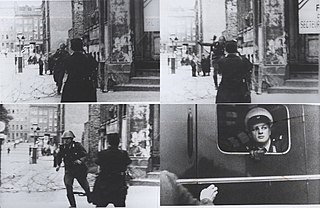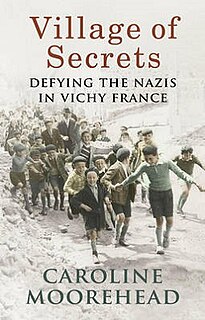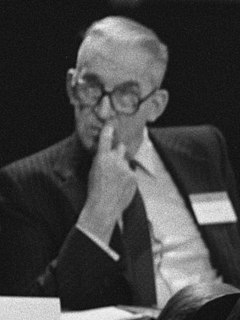
A refugee, generally speaking, is a displaced person who has crossed national borders and who cannot or is unwilling to return home due to well-founded fear of persecution. Such a person may be called an asylum seeker until granted refugee status by the contracting state or the United Nations High Commissioner for Refugees (UNHCR) if they formally make a claim for asylum. The lead international agency coordinating refugee protection is the United Nations Office of the UNHCR. The United Nations has a second office for refugees, the United Nations Relief and Works Agency (UNRWA), which is solely responsible for supporting the large majority of Palestinian refugees.
The right of return is a principle in international law which guarantees everyone's right of voluntary return to, or re-entry to, their country of origin or of citizenship. The right of return is part of the broader human rights concept freedom of movement and is also related to the legal concept of nationality. While many states afford their citizens the right of abode, the right of return is not restricted to citizenship or nationality in the formal sense. It allows stateless persons and for those born outside their country to return for the first time, so long as they have maintained a "genuine and effective link".

Le Chambon-sur-Lignon is a commune in the Haute-Loire department in south-central France.
The National Front was a World War II French Resistance movement created to unite all of the Resistance Organizations together to fight the Nazi occupation forces and Vichy France under Marshall Pétain. Founded in 1941 in Paris by Jacques Duclos, André Pican and Pierre Villon, along with their wives all members of the French Communist Party (PCF) they felt that to be a vital force against the Nazis, the collaborationists and the informers that all of the Resistance movements, no matter their party or religion had to band together. Its name was inspired by the Popular Front, a left-wing coalition which governed France from 1936 to 1938. This helped them coordinate attacks all across France, to move weapons, food, false identity papers, information and food, protect and move people who were to be arrested or executed and supply multiple safe houses for the Resistance and for Jews. They also formed fighting units in early 1942 to assassinate German leaders and soldiers among the occupation forces, perform acts of sabotage on railroads and other forms of distribution of people and goods being taken from France to Germany and to help organize sabotage in factories forced to produce armaments and goods for the German military.

Aliyah Bet was the code name given to illegal immigration by Jews, most of whom were refugees escaping from Nazi Germany, and later Holocaust survivors, to Mandatory Palestine between 1920 and 1948, in violation of the restrictions laid out in the British White Paper of 1939, which dramatically increased between 1939 and 1948. With the establishment of the State of Israel in May 1948, Jewish displaced persons and refugees from Europe began streaming into the new sovereign state.

André Trocmé and his wife, Magda, were a French couple designated Righteous Among the Nations. For 15 years, André served as a pastor in the French town of Le Chambon-sur-Lignon, on the Plateau Vivarais-Lignon, in south-central France. He had been accepted to the rather remote parish because of his pacifist positions, which were not well received by the French Protestant Church. In his preaching, he spoke out against discrimination as the Nazis were gaining power in neighboring Germany and urged his Protestant Huguenot congregation to hide Jewish refugees from the Holocaust of the World War II.

Displaced persons camps in post–World War II Europe were established in Germany, Austria, and Italy, primarily for refugees from Eastern Europe and for the former inmates of the Nazi German concentration camps. A "displaced persons camp" is a temporary facility for displaced persons, whether refugees or internally displaced persons. Two years after the end of World War II in Europe, some 850,000 people lived in displaced persons camps across Europe, among them Armenians, Poles, Latvians, Lithuanians, Estonians, Yugoslavs, Jews, Greeks, Russians, Ukrainians, Hungarians and Czechoslovaks.

Sh'erit ha-Pletah is a Hebrew term for Jewish Holocaust survivors living in Displaced Persons (DP) camps, and the organisations they created to act on their behalf with the Allied authorities. These were active between 27 May 1945 and 1950–51, when the last DP camps closed.

HIAS is a Jewish American nonprofit organization that provides humanitarian aid and assistance to refugees. It was originally established in 1881 to aid Jewish refugees. In 1975, the State Department asked HIAS to aid in resettling 3,600 Vietnam refugees. Since that time, the organization continues to provide support for refugees of all nationalities, religions, and ethnic origins. The organization works with people whose lives and freedom are believed to be at risk due to war, persecution, or violence. HIAS has offices in the United States and across Latin America, Europe, Africa, and the Middle East. Since its inception, HIAS has helped resettle more than 4.5 million people.

Holocaust survivors are people who survived the Holocaust, defined as the persecution and attempted annihilation of the Jews by Nazi Germany and its allies before and during World War II in Europe and North Africa. There is no universally accepted definition of the term, and it has been applied variously to Jews who survived the war in German-occupied Europe or other Axis territories, as well as to those who fled to Allied and neutral countries before or during the war. In some cases, non-Jews who also experienced collective persecution under the Nazi regime are also considered Holocaust survivors. The definition has evolved over time.
The Central British Fund for World Jewish Relief, which operates under the name World Jewish Relief, is a British Jewish charitable organisation and is the main Jewish overseas aid organisation in the United Kingdom. World Jewish Relief was formed in 1933 as a support group to German Jews under Nazi rule and played a major role in organising the Kindertransport which rescued around 10,000 German and Austrian children from Nazi Europe. After the war, the organisation brought 732 child Holocaust survivors to Britain; the first 300 are known as The Windermere Children and collectively they are known as The Boys. Currently, World Jewish Relief functions as one of Britain's leading development organizations, working with Jewish and non-Jewish communities alike. World Jewish Relief operates programmes mainly in the former Soviet Union but also in Eastern Europe, Africa, and Asia.

After Adolf Hitler came into power in 1933 and enacted policies that would culminate in the Holocaust, Jews began to escape German-occupied Europe and the United Kingdom was one of the destinations. Some came on transit visas, which meant that they stayed in Britain temporarily, while waiting to be accepted by another country. Others entered the country by having obtained employment or a guarantor, or via Kindertransport. There were about 70,000 Jewish refugees who were accepted into Britain by the start of World War II on 1 September 1939, and an additional 10,000 people who made it to Britain during the war.
The problem of Kurdish refugees and displaced people arose in the 20th century in the Middle East, and continues today. The Kurds, are an ethnic group in Western Asia, mostly inhabiting a region known as Kurdistan, which includes adjacent parts of Iran, Iraq, Syria, and Turkey.

Madeleine Barot was a French activist and theologian, who was influential in Protestant, humanist, and human rights movements.

The Holocaust in France was the persecution, deportation, and annihilation of Jews and Roma between 1940 and 1944 in occupied France, metropolitan Vichy France, and in Vichy-controlled French North Africa, during World War II. The persecution began in 1940, and culminated in deportations of Jews from France to Nazi concentration camps in Nazi Germany and Nazi-occupied Poland. The deportation started in 1942 and lasted until July 1944. Of the 340,000 Jews living in metropolitan/continental France in 1940, more than 75,000 were deported to death camps, where about 72,500 were murdered. The government of Vichy France and the French police organized and implemented the roundups of Jews. Although most deported Jews were killed, the survival rate of the Jewish population in France was up to 75%, which is one of the highest survival rates in Europe.

Village of Secrets: Defying the Nazis in Vichy France is a 2014 book by Caroline Moorehead.
A refugee crisis can refer to difficulties and dangerous situations in the reception of large groups of forcibly displaced persons. These could be either internally displaced, refugees, asylum seekers or any other huge groups of migrants.

After Adolf Hitler came into power in 1933, Jews began to escape German-occupied Europe.
Jacques Martin (1906–2001) was a French pacifist, one of the first conscientious objectors in France, and a Protestant pastor. His commitment to French Resistance and to the protection of persecuted Jews earned him the recognition of Yad Vashem as a "Righteous Among the Nations." He died in Die on 23 July 2001.

Jacques Maury was a French pastor.